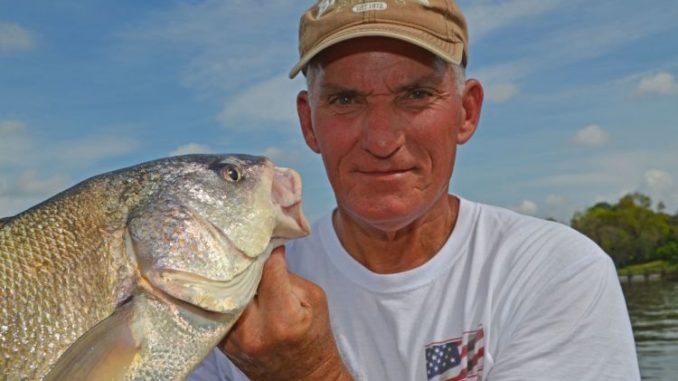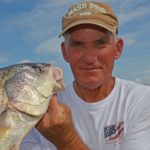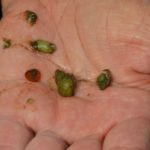
Gaspergou may be looked down upon by some bass anglers, but Mike Kelley Sr. has etched his name into the state record books with plenty of False River freshwater drum.
My eyes popped.
I was scrolling through the Louisiana Fish Records Program when I got to the category labeled “Freshwater Drum (Gaspergou),” I saw that four of the Top 10 entries were held by one man — Mike Kelley Sr. — and all were caught in False River.
Furthermore, another two drum caught by two other anglers also came from the same big oxbow lake in Point Coupee Parish. Was there something magical about this lake? And what did Mike Kelley know about it?
I was determined to find out.
I expected that I would find a high-strung, intense hot dog. What I found was a low-key, slow-talking, seemingly hard-to-rile 64-year-old retired widower. Only the fire in the slim, tanned man’s brown eyes gave away his fierce passion for fishing.
His modest but immaculately neat brick house in Oscar was set on the shores of False River in the middle of “Millionaires’ Row,” so named because of the size of its camps and residences.
“I tell people I am the gardener for those places,” he joked.
He had a sense of humor, too.
Before I left home, Kelley directed me to bring an ice chest if I like to eat “gou-fish.” (Louisianans invariably contract the gaspergou’s name to “gou.”)
Kelley releases all the freshwater drum he catches unless they look to be record book size. “I catch them for the love of fishing,” he said softly. “I love to feel the pull on my rod.”
Fishing with him was almost too easy and laid back. The entrance to Lighthouse Canal, his destination, was only a quarter-mile from his home. He anchored in 8 feet of water outside the mouth of the canal, and cast away from the bank toward the open lake.
A gentle current was moving into the canal from the lake.
“Gou and hybrid stripers are my main catch here,” he said, “but I also catch a lot of catfish.” All he had for bait was 2 or 3 pounds of live crawfish, not the tiny bait-sized ones, but rather crawfish big enough to boil and eat.
He kept the crawfish in a 5-gallon bucket with a small block of ice to keep them cool. In spite of the ice in the bucket, Kelley assured me that it didn’t matter if they die. “They are still good bait.
“Hybrid stripers love crawfish. It’s hard to believe that an active gamefish would take a dead crawfish off the bottom.”
Things happened quickly. A tap on his bait sparked Kelley to throw a vicious hookset on a channel catfish, the first of many good-eating size 1 ½ to 2 ½ pound cats he reeled in.
“You can tell fish apart by their bites,” he said quietly. “Catfish go ‘tap-tap-tap’ and then take it. Gou-fish and hybrid stripers hit it hard and go. They hit it like they want to kill it.”
He seldom let the bait set in one spot long, rather off-and-on slowly retrieving it. The bait was always in contact with the bottom though.
When his bait becomes ragged from repeated hits, he just left it on the hook and kept on fishing. “Appearance means nothing. I usually fish with them until they fall off,” he chuckled.
Although the hybrid stripers seemed to have business elsewhere that day, generous numbers of catfish and the usual strong run of gou more than made up for their absence.
During each fight, he could pick what species was on the end of his line with 100 percent accuracy. “Catfish spin and roll coming in,” he explained. “Gou throw their head from side to side and hybrid stripers make hard straight runs. They can make the line zing going through the water.”
It was a peaceful day with an easy, gentle breeze. No water skiers, jet skis or tubers were in sight. “It gets hard after the water warms up,” he admitted about the water sports activity on the lake.
The traffic on nearby Highway 1 hummed as people hustled and bustled along with their busy lives. Likely, few of them even noticed the man catching fish after fish not far off the bank.
The sweet spot
Unlike many fishermen, Mike Kelley doesn’t mind sharing the location of his honey hole. All six record freshwater drum taken from False River came from just outside the mouth of Lighthouse Canal.
Formally known as the Bayou Grosse Tete Drainage Canal, Lighthouse Canal serves as the “drainage ditch” that carries excess rainwater from the lake to Bayou Grosse Tete.
Formed from an abandoned channel of the Mississippi River, False River is shaped like a giant letter C. The lake’s shoreline on the outside of the C (western shore) is paralleled by Louisiana State Highway 1, and naturally called the “Highway 1 Side.” The opposite shore, on the inside of the C (eastern shore), is always referred to as the “Island Side.”
Lighthouse Canal exits the lake on the southern end of the Highway 1 Side. Lake water levels are controlled by three movable 8-foot by 8-foot roller gates set under the highway. The canal itself is only about 75 feet wide.
Legally considered private, access to the canal is restricted, but Kelley gets all the action he wants outside the mouth of the canal. Bulkheaded shores on either side of the mouth of the canal create something of a funnel to the canal’s entrance.
At one time or another, Kelley will fish the entire area of the “funnel,” typically casting toward the open water of the lake.
“Fishing is best here when there is a current going into the canal,” he noted. “Rainfall into (the lake) raises water levels, resulting in drainage out the canal. Long periods without rain mean no current.”
Slightly complicating fishing plans are drawdowns by the Louisiana Department of Wildlife and Fisheries in recent winters. The drawdowns are conducted to firm up the exposed bottoms for better bass spawning success, and to improve plant habitat.
The gates are usually closed to restore water levels to normal in mid-January, although this year an unexpectedly heavy rain forced earlier closure.
Although the normal flow of current is from the lake into the canal, flood rains in the Grosse Tete basin can raise water levels in the bayou enough to create a temporary reverse flow situation.
Kelley was turned on to the spot by his brother-in-law Kirby Jarreau, who used to be chief of police in New Roads. “He tied to a bulkhead and fished live crawfish, primarily for catfish.”
Kelley said that he entered his first freshwater drum in the records in 2005. “I caught a big one from my boat. I was going to turn it loose when a guy named Jimmy Doiron, who was fishing from the bank encouraged me to enter it in the records. He had two in the books at the time from the same spot.
“He said, ‘I’ll show you what to do.’ He even took me to get it weighed.”
“After pictures of my first two record fish were printed in the newspaper, a guy from Livonia, Stephen Morgan came here the next week and caught another one.”
Keep it simple
This is leisurely fishing — no high-tech, high-paced grind. In tune with that, the gear used is not demandingly fine-tuned, like it is for the finesse crappie jigging that Mike Kelley also loves.
You can use economically-priced reels, he says. There is no need here for long, pin-point casts. He uses level wind reels, but admits that spinning reels will work just as well. “I just never was a fan of spinning reels,” he quipped.
Because of the fighting qualities of the fish he catches, he spools his reels with 20-pound test line.
He favorite hooks are 4/0 Eagle Claw O’Shaughnessy Lazer Sharp hooks. Two #4 split shots pinched on the line immediately above the hook provide enough weight for casting, and are also heavy enough to keep the bait on the bottom.
Hitting the books
In the Louisiana Fish Records Program, the Freshwater Drum category is a very competitive one — and the fish grow to respectable sizes. It takes at least an 18-pound, 4-ounce fish to make it into 10th place. The No. 1 fish is 25 pounds, 7 ounces.
Freshwater drum don’t receive the respect they are due, according to Mike Kelley. Once an avid bass fisherman himself, he speaks with authority about how bass anglers view a freshwater drum that strikes their lures.
“When the average bass fisherman catches a gou, they think it is the slimiest, trashiest fish that swims. ‘They are as low as a fish can go. How dare they take my bait?’
“I just take it with a grain of salt,” he grinned. “If they had four fish in the records, their chest would be sticking out.
“Gou fight harder than largemouths, especially at first. Some of them kind of give up at the very end though.”
Placing a fish of any species in the record books is relatively easy if a few points are remembered. The fish should be kept from drying out to retain its weight, and it must be weighed on an officially certified scale (like at a grocery store or marina).
Most challenging is finding a biologist to certify the species of the fish. Most people opt for Louisiana Department of Wildlife and Fisheries biologists, but university or privately employed biologists are qualified to do so as well. The Louisiana Outdoor Writers Association, which maintains the records, requires the certification to protect the integrity of the records.
A listing of current records, plus the program rules, and an application can be found on the Louisiana Outdoor Writers Association website. The records may also be found on other websites, but they are often not updated as frequently as they are at the official location.


